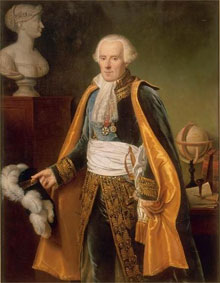
Portait of Laplace, oil on canvas, by Jean-Baptiste Paulin Guérin. Image courtesy of the Museum of Versailles.
Laplace
Pierre-Simon de Laplace (23 March 1749 – 5 March 1827) was the first to place astronomy on a modern mathematical basis. In his five-volume Mécanique Céleste (Celestial Mechanics(1799–1825) he reformulated classical mechanics in terms of the calculus, rather than the geometric constructions used by Newton, and made a wide variety of new applications to celestial mechanics. He was also a founding father of probability theory, and made major contributions to the theory of sound, wave theory, and harmonic analysis.
Laplace was one of the first to speculate on the existence of black holes and the notion of gravitational collapse. He was also the originator of the idea that a sufficiently intelligent being (a ‘Laplace demon’), provided with initial data of absolute precision, could predict the entire subsequent unfolding of the universe. He denied that Divine intervention was required to maintain the motions of the planets in their orbits, contrary to Newton’s suggestion.
Laplace was born in Beaumont-en-Auge, Normandy, the son of merchants and farmers. He was schooled in a Benedict priory and at the University of Caen, where he was educated in mathematics. He subsequently studied under Jean d’Alembert in Paris. He became associate member of the Academie des Sciences in 1774, at the age of twenty-four.
Links
Gallica Biblioteque Numerique: Oeuvres Completes de Laplace >
